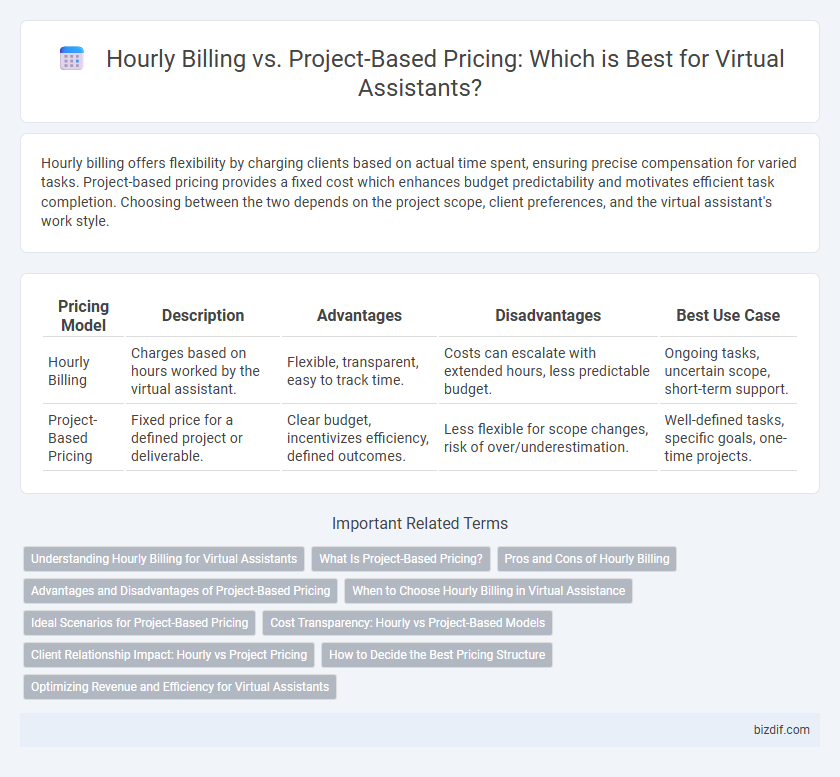Hourly billing offers flexibility by charging clients based on actual time spent, ensuring precise compensation for varied tasks. Project-based pricing provides a fixed cost which enhances budget predictability and motivates efficient task completion. Choosing between the two depends on the project scope, client preferences, and the virtual assistant's work style.
Table of Comparison
| Pricing Model | Description | Advantages | Disadvantages | Best Use Case |
|---|---|---|---|---|
| Hourly Billing | Charges based on hours worked by the virtual assistant. | Flexible, transparent, easy to track time. | Costs can escalate with extended hours, less predictable budget. | Ongoing tasks, uncertain scope, short-term support. |
| Project-Based Pricing | Fixed price for a defined project or deliverable. | Clear budget, incentivizes efficiency, defined outcomes. | Less flexible for scope changes, risk of over/underestimation. | Well-defined tasks, specific goals, one-time projects. |
Understanding Hourly Billing for Virtual Assistants
Hourly billing for virtual assistants involves charging clients based on the actual time spent on tasks, promoting transparency and flexibility in workload management. This method allows precise tracking of hours through tools like Toggl or Harvest, ensuring clients pay only for the time dedicated to their projects. Virtual assistants benefit from hourly billing by accommodating fluctuating task volumes and adapting rates according to skill level and service complexity.
What Is Project-Based Pricing?
Project-based pricing is a billing method where a fixed fee is agreed upon for the entire scope of a virtual assistant's services, regardless of the time spent. This model emphasizes clear deliverables and outcomes, providing clients with predictable costs for specific projects such as social media management or email organization. It contrasts with hourly billing by prioritizing value and efficiency over time tracking, benefiting both clients and assistants in managing expectations and budgets.
Pros and Cons of Hourly Billing
Hourly billing for virtual assistants offers flexibility by allowing clients to pay only for the time worked, which suits dynamically changing tasks or projects with unclear scopes. However, this model can lead to unpredictability in budgeting and potential disputes over time tracking, impacting client satisfaction. Transparently tracking hours and setting clear expectations helps maximize the benefits of hourly billing while mitigating its drawbacks.
Advantages and Disadvantages of Project-Based Pricing
Project-based pricing offers clear cost expectations and simplifies budgeting by defining a fixed fee upfront, reducing the risk of unexpected expenses for clients. It encourages efficient work completion but may limit flexibility if project scope changes, potentially leading to scope creep disputes or added costs. This pricing method benefits clients with well-defined projects but can deter virtual assistants from accommodating evolving requirements without renegotiation.
When to Choose Hourly Billing in Virtual Assistance
Hourly billing in virtual assistance is ideal when tasks are unpredictable, scope frequently changes, or ongoing support is required, allowing for flexible and accurate compensation based on actual time spent. This model is beneficial for clients needing assistance with varied assignments such as email management, scheduling, or research that cannot be easily quantified upfront. Virtual assistants can track hours precisely using tools like Toggl or Harvest, ensuring transparency and fair billing for both parties.
Ideal Scenarios for Project-Based Pricing
Project-based pricing is ideal for virtual assistant tasks with clearly defined deliverables and timelines, such as managing a product launch or organizing a one-time event. This pricing model suits projects where scope and outcomes are predictable, allowing for fixed budgets and reducing billing disputes. Clients benefit from cost transparency and streamlined payments, while virtual assistants can efficiently allocate resources without tracking hours.
Cost Transparency: Hourly vs Project-Based Models
Hourly billing offers clear cost transparency by tracking work hours in real time, allowing clients to monitor expenses closely and adjust project scope as needed. Project-based pricing provides upfront cost certainty, enabling clients to budget efficiently with a fixed fee that covers the entire virtual assistant task. Each model balances flexibility and predictability, influencing client decisions based on their preference for dynamic invoicing or predetermined financial commitments.
Client Relationship Impact: Hourly vs Project Pricing
Hourly billing fosters transparency and ongoing communication, allowing clients to track progress and adjust scope in real time, which can build trust and collaboration. Project-based pricing provides predictable costs and clear deliverables, reducing client anxiety about budget overruns and encouraging long-term commitment. Choosing the right pricing model impacts client satisfaction and relationship longevity by aligning expectations and communication frequency.
How to Decide the Best Pricing Structure
Choosing the best pricing structure for a virtual assistant depends on the scope and complexity of tasks involved; hourly billing suits ongoing, variable workloads while project-based pricing benefits well-defined, finite assignments. Analyze client needs, task duration, and predictability to determine whether a flexible or fixed cost approach maximizes value and efficiency. Transparent communication about expectations and deliverables ensures alignment and optimal pricing strategy selection.
Optimizing Revenue and Efficiency for Virtual Assistants
Virtual assistants optimize revenue and efficiency by choosing between hourly billing and project-based pricing based on client needs and task complexity. Hourly billing ensures fair compensation for variable workloads, while project-based pricing provides predictable income for well-defined deliverables. Balancing these models maximizes profitability and client satisfaction in virtual assistant services.
Hourly billing vs Project-based pricing Infographic

 bizdif.com
bizdif.com